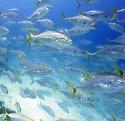
350.org‘s planetary day of action is well under way, with schools actions happening all over New Zealand — that’s Remuera Intermediate above, taking their jumpers off for climate action. Tomorrow’s the big day, with over 130 350 Aotearoa actions scheduled all round the country. You can find one near you at 350.org.nz. Lend a hand. Send a message.

This is Jane Filemu, a 9 year-old Samoan girl taking part in 350 Islands For Change, an Oxfam-organised action at Takapuna beach in Auckland today. With Pacific Island nations being hung out to dry by the developed world, islanders waded out to a giant washing line and hung up 350 tee-shirts, each printed with the name of an island. Jane hung up the final shirt, recited a poem and then told the crowd:
“I have a choice to be one of many, to make a better world for the future of Aotearoa, Pasifika, our planet. Everyone has the power to choose wrong or right. Family, we can work together, we can make a change. Alofa, Aroha, Peace!â€
My action? Colin King MP is turning up to open Amberley Farmers Market’s summer season. I’ll be having a chat to him about climate reality. 350 words, at the very least (and the mayor won’t escape either). 😉

 There are hours of harmless fun to be had digging around in the submissions to the
There are hours of harmless fun to be had digging around in the submissions to the  Wind, solar and water sources are sufficient to provide the world’s energy by 2030. Scientific American has a front cover article coming up in November to demonstrate that. Written by
Wind, solar and water sources are sufficient to provide the world’s energy by 2030. Scientific American has a front cover article coming up in November to demonstrate that. Written by  Perhaps it will register if it’s expressed in money terms. The latest issue of the New Scientist carries an
Perhaps it will register if it’s expressed in money terms. The latest issue of the New Scientist carries an